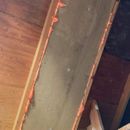Reclaimed polyiso – which location is best to use
Hello experts!
I’m building a small 70 sq.ft. office by converting the back of my garage plus a bumpout. I collected some reclaimed insulation and looking for advice on the best locations to use it.
300 sq.ft. of 3″ fiberglass faced polyiso
560 sq.ft. of 3/4″ Dow XPS
Existing roof is not vented, the walls are 2×4, and the floor is 2×6.
My current thinking is to fill the roof and some of the wall cavities with the polyiso. When I run out of polyiso to foam in the XPS on the walls and then use all the remaining XPS in the floor and just stack them to fill the cavity. Once everything is air sealed any leftover cavities will be filled with rockwool.
I’m concerned about the fiberglass facing though and the potential for it to absorb moisture so I was wondering if using it in the floor would be OK.
The bumpout of the floor will be very close to the ground (not doing a slab) so I’m planning to use XPS on the underside of the joists as well as PT ply to cover that and make sure the area under the bumpout is several inches of gravel and not just dirt.
Here is a pic of one panel of polyiso I installed just to see how it goes.
GBA Detail Library
A collection of one thousand construction details organized by climate and house part











Replies
Do you have a vent channel above that foamed in polyiso panel in the roof? You really don't want to use it directly against the roof sheathing in an unvented assembly, such assemblies are risky over time. If you leave a vent channel (at least 1") above it that goes from eave to roof, and you have soffit and ridge vents, then you'll be fine.
I personally would try to use the rigid foam on the exterior of the walls over the studs, and batts in the stud bays, for better performance and easier installation. It sounds like you are trying to use the reclaimed material as much as possible for everything though, in which case I'd use the 3" polyiso in the walls towards the interior and the 1/2" XPS towards the exterior to make up the full 3.5" depth of a typical 2x4 stud bay.
I don't see any issue using either material under the floor, just be sure to protect it from critter damage. You won't have any issues with moisture absorption with the polyiso as long as you keep it up off the ground and away from any sources of bulk water (i.e. don't position it where it might be sitting in a puddle at times). The XPS doesn't care if it gets wet, so you can use that against the ground or anywhere that might get wet.
Bill
Don't mean to derail but-
I see the concern of water absorption with polyiso a lot here on gba but then I look here https://www.rmax.com/below-grade-water-absorption and polyiso = xps in that regard This product is also sold for ground contact/below grade exterior.
Granted I know there is the fiberglass faced vs foil but in regards to just the polyiso itself, the water absorption findings are confusing.
Thanks Bill. I don’t have any venting in the roof. As you can see in the pics the garage wasn’t built with any.
I read that when venting wasn’t an option it was recommended to go against the roof deck and foam it in for air seal. Perhaps I was mistaken?
The bottom of floor joists is about 4” off the ground and I’ll cover with PT ply but what you said confirms what I read about the polyiso w figerglass that it's OK in a floor if it's properly sealed.
thanks!
You didn't need a vented roof when it was all open inside like a shed. Now that you're closing it up, there is a potential issue. If you don't have venting, then the best way to go is closed cell spray foam for a FULLY ADHERED insulating layer. "foamed in" rigid foam really isn't sufficient to ensure you don't have moisture problems.
The facer on the polyiso doesn't make loads of difference with water tolerance -- foil faced polyiso will also suck up water through it's exposed edges if left in a puddle. The fiberglass faced polyiso is more vapor open though, which means it does allow for a small amount of drying for the structure, and it is not a vapor barrier the way that foil faced polyiso is (due to the foil facer on the foil faced polyiso).
Bill
Bill can you point me to any resources for that? I read several articles and posts, including on this forum that said if the closed cell foam is carefully air sealed against the roof deck then it is safe to do so.
Glad to know about the fiberglass facing not being too much of a concern.
jeuteneier,
https://www.greenbuildingadvisor.com/article/cut-and-cobble-insulation
https://www.greenbuildingadvisor.com/article/theres-rot-in-the-roof